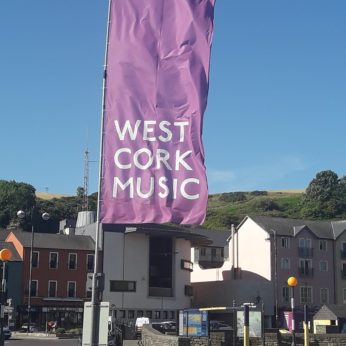Composer: César Franck (b. 1822 - d. 1890)
Performance date: 06/07/2019
Venue: Bantry Library
Composition Year: 1889
Duration: 00:43:56
Recording Engineer: Ciaran Cullen, RTÉ
Instrumentation: 2vn, va, vc
Instrumentation Category:String Quartet
Artists:
Quatuor Zaïde (David Haroutunian [violin], Leslie Boulin Raulet [violin] Sarah Chenaf [viola] Juliette Salmona [cello]) -
[quartet]

Quatuor Zaïde
David Haroutunian, Leslie Boulin Raulet [violins]
Sarah Chenaf [viola], Juliette Salmona [cello]
Cesar Franck [1822-1890]
Quartet in D major [1889]
1. Poco lento – Allegro
2. Scherzo: Vivace
3. Larghetto
4. Allegro molto
Cesar Franck had been considering writing a string quartet since the 1870s. For a number of years there appeared to be little progress. In 1888, his piano was reportedly covered with the scores of quartets by Beethoven, Schubert and Brahms. A year later, he had completed this work and it was given its first performance in April 1890. It was his last completed composition and, rarely for Franck, a great success. As the composer himself remarked at last the French public appear to be appreciating me. Unfortunately, Franck did not live long enough to enjoy this success. He died in November 1890, probably because of injuries sustained in a road traffic accident.
Much of Franck’s life had been a struggle. His early life had been dominated by his father who wanted him to be a great piano virtuoso in the manner of Franz Liszt. Although Franck’s early piano recitals were a success, he preferred playing the organ and composing. Even though Liszt himself gave his support and encouragement, Franck’s compositions were rarely successful. However, the churches of Paris always needed good organists and Franck held the position of chief organist in a number of them. His skills as an organist, particularly his ability to improvise, became widely recognised, eventually leading to a chair at the Paris Conservatoire.
When composing this quartet, Franck may have studied the quartets of his illustrious predecessors, the style is unmistakeably his own. Franck shows enormous knowledge and understanding of the many possible quartet textures; from light and shimmery to the robust and passionate. His harmonies are essentially late romantic but they are laced with more astringent discords which anticipate modernism. No wonder Debussy admired this quartet. Throughout this quartet, Franck displays his complete mastery of musical form and produces a magnificent and influential work.
The first movement opens in a declarative manner with the first violin playing the main cyclic theme over unison chords. This theme mainly consists of a declining sequence of notes preceded by a swooping leap upwards of over an octave. The tempo is slow (poco lento). After the opening fortissimo, the music becomes quieter for a few bars and the opening theme is played on the cello. Soon the theme returns played again fortissimo on the first violin. The first of these slow sections ends with a beautifully calm passage. In the allegro which follows, a number of new ideas are introduced. The first exploits dotted rhythms. Another has a rippling effect based on the repetition of two notes a semi-tone apart. When this theme is played at a slower tempo, the poco lento music returns. This time it is introduced by the viola and then passed to the second violin. Soon all four instruments are playing in counterpoint. The return of the allegro marks the passionate climax of the development and the movement concludes with the opening theme and a wonderfully peaceful coda.
While the first, third and final movements of this work are predominately serious, the second movement scherzo is both charming and hilarious. The first idea is delightfully comic. The second is a more lyrical dance. A feature of this movement is that after a phrase or two, Franck often inserts a bar of silence. As if to say, well what do you think of that? In fact it can be argued that the bar of silence becomes a musical theme in its own right.
The slow movement is solemn, serene and, at times, melancholy. The harmonies become both warmer and darker. There is a tempestuous middle section and after the movement returns to the original material, there is one last passionate outburst before a poignant conclusion. The Finale opens with another declarative passage played fortissimo. There follow quotations from each of the previous three movements. It is hard not to be reminded of the opening to the last movement of Beethoven’s ninth symphony; but no soloists or chorus are required here. This movement becomes a brilliant virtuoso quartet finale. An idea based on four loud repeated chords is developed in astonishing ways. It is frequently used as a transition to quieter, sometimes almost ghostly passages. Themes from previous movements return once more and the quartet ends, just as Beethoven’s ninth symphony does, in a blaze of glorious affirmation in D major.
David Winter
Copyright © 2025 West Cork Music. All rights reserved.
Designed and developed by Matrix Internet